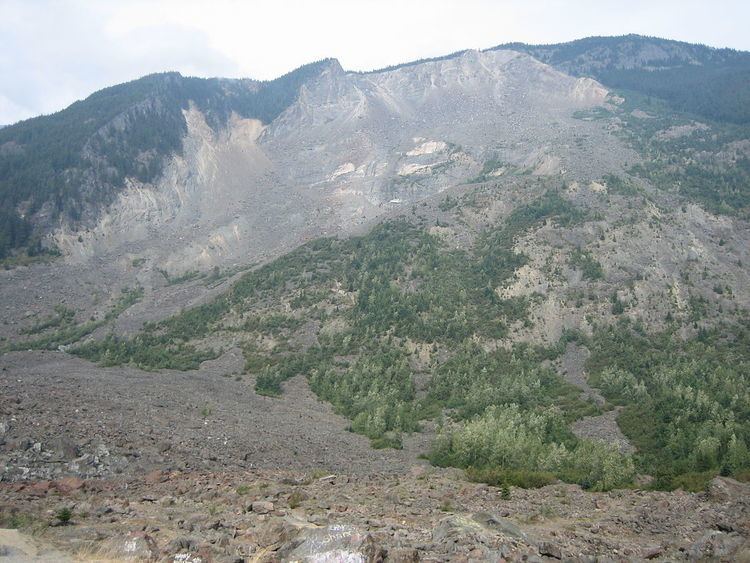 | ||
The Hope Slide was the largest landslide ever recorded in Canada. It occurred in the morning hours of January 9, 1965 in the Nicolum Valley in the Cascade Mountains near Hope, British Columbia, and killed four people. The volume of rock involved in the landslide has been estimated at 47 million cubic metres.
Contents
Prior avalanche
Prior to the landslide, a small avalanche had forced four people to stop their vehicles a few miles southeast of the town of Hope, British Columbia—150 kilometres (93 mi) east of Vancouver—on a stretch of the Hope-Princeton Highway below Johnson Peak. As those people contemplated waiting for clearing crews or turning around, a second slide occurred.
Landslide
Two earthquakes were said to have been recorded in the general area of the slide. One quake occurred at 3:56 am and the second at 6:58 am. The slide that obliterated the mountain's southwestern slope was discovered when members of the RCMP detachment at Hope B.C. were dispatched to what were first reported as a couple of small rock slides. The first news reports of the slide were from CHWK Radio in Chilliwack where morning news reporter Gerry Pash and later news director Edgar Wilson filed voice reports with Broadcast News and Canadian Press. The slide buried a Chevrolet sedan with two occupants, another car and driver, and a tanker truck and its driver under a torrent of 47 million cubic meters of pulverized rock, mud, and debris 85 metres (279 ft) deep and 3 kilometres (1.9 mi) wide, which came down the 2,000-metre (6,600 ft) mountainside. This mass of debris completely displaced the water and mud in Outram Lake below with incredible force, throwing it against the opposite side of the valley, wiping all vegetation and trees down to the bare rock, then splashed back up the original (now bare) slope before settling. Recent research shows that these impacts against the opposite valley sides produced the seismic signatures interpreted as earthquakes.
Rescue crews only found two of the four bodies—the others have remained entombed under the rock since 1965. A Greyhound Lines bus traveling to Hope was stopped just before the slide. The driver turned back and was credited with saving his passengers from a tragedy.
British Columbia Highways Minister Phil Gaglardi personally attended at the scene and directed the construction of a temporary "shoofly" road over the southern portion of the slide.
Cause
The landslide was caused by the presence of pre-existing tectonic structures (faults and shear zones) within the southwestern slope of Johnson Ridge. The lower parts of the slide scar are underlain by felsite sheets (which may have failed first) while the upper parts of the slide scar are underlain by highly jointed Paleozoic greenstone beds. Ongoing weathering and tectonic activity weakened the slide mass to the point where it had reached limiting equilibrium. Johnson Peak was the site of a previous smaller prehistoric rock-slide.
Just what triggered the 1965 landslide remains unclear; the two so-called earthquakes were likely too small to trigger the slide and thus the seismic events were more likely caused by the impact of the landslide masses on the opposite valley wall. Changes in groundwater condition, often a trigger for landslides, is not thought to have played a role in the Hope Slide as the slide occurred during a protracted period of sub-zero temperatures in the winter, though some have suggested that freezing of seepage exit points may have caused an increase in water pressure at the toe of the slide.
Result
The highway has since been rerouted around and over the base of the slide's debris field 55 metres above the original ground level on the other side of valley. Most of the massive scar on the mountain face remains bare rock, without significant growth of trees or other large vegetation. It is quite easily visible from aircraft passing overhead.
A view point on Highway 3 allows tourists to view the scar.
A four kilometre stretch of the prior routing lays disused to the north of the new highway alignment.
Aircraft
On August 13, 1965, an aircraft piloted by S.W.K. Stevenson crashed, killing him.
On April 23, 1966, a Royal Canadian Air Force Grumman CSR-110 Albatross (9302) serving with No. 121 Composite Unit (KU) at RCAF Station Comox, BC crashed on the Hope Slide. It was the only RCAF Albatross loss. Five of the six crew members died (Squadron Leader James L. Braiden (passenger), Flying Officer Christopher J. Cormier (radio operator), Leading Aircraftsman Robert E. MacNaughton (crewman), Flight Lieutenant Phillip L. Montgomery (co-pilot), and Flight Lieutenant Peter Semak (pilot)). Flying Officer Bob Reid (navigator) was the sole survivor. A portion of the wreckage is still visible and can be hiked to.
